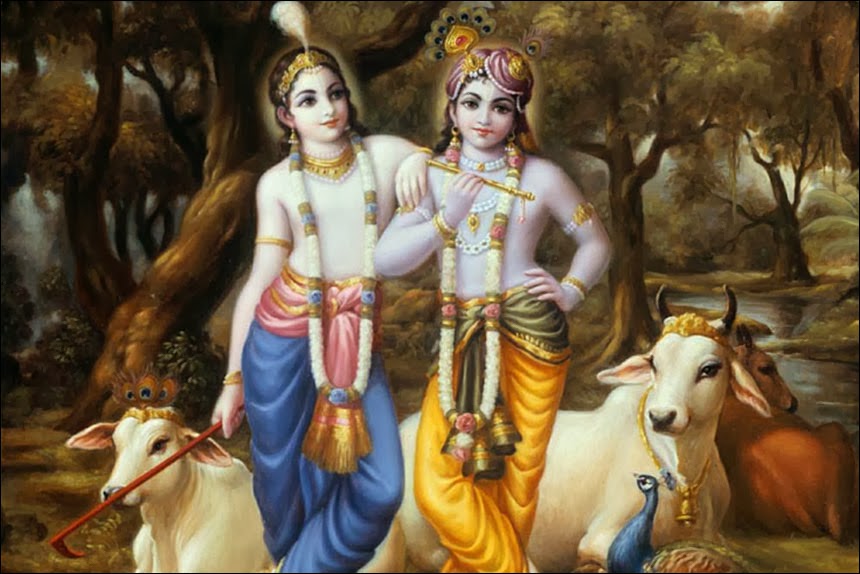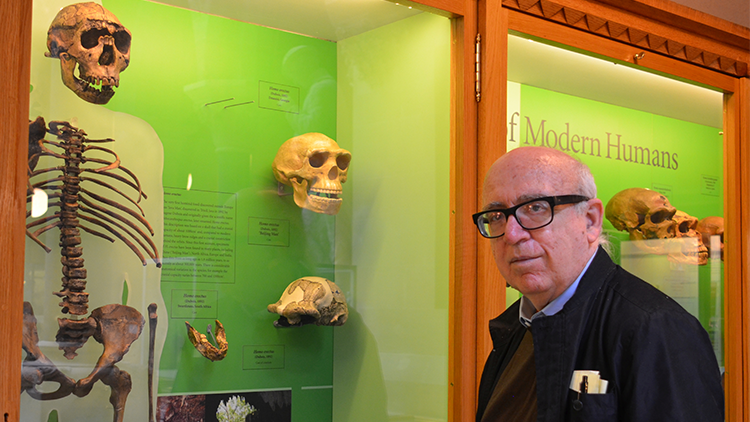Lord Sri Krishna and Balarama are not avataras of black and white hairs of Lord Vishnu
From Sri Tattva Sandarbha of Srila Jiva Goswami
Objection:
Is it not so that (Krishna and Balarama), who appeared in the Yadu dynasty, are incarnations of a black and white hair of Lord Vishnu. This is clearly described in Shrimad-Bhagavatam (2.7.26):
“When the world is overburdened by the fighting strength of kings who have no faith in God, just to diminish the distress of the world, a black and white hair of the Lord incarnate on the earth. To expand His transcendental glories the Lord acts extraordinarily. No one can properly estimate how great He is.”
Many translators have interpreted the above verse of Srimad Bhagavatam, a verse from Vishnu Purana and Mahabharata to mean Lord Krishna and Balarama are incarnations of black and white hairs of Lord Visnu respectively.

Refutation:
(To this objection I (Srila Jiva Goswami) reply:) O, don’t interpret this verse in that way. Please listen and I will now give the proper interpretation of the verse. The word “kalaya” means with great artistry”, “sita” means “bound”, and “krishna” means “very dark”. The compound word “sita-Krishna-kesha” means “He whose beautiful black hair is neatly tied”. The word “kalaya” indicates that Lord Krishna was the most expert of all artists.
Note: The entire verse may then be interpreted in the following way:
“When the world is overburdened by the fighting strength of kings who have no faith in God, the Lord, just to diminish the distress of the world, descends in His original form, with beautiful black hair neatly tied on His head. The Lord is the most expert of all artists, and just to expand His transcendental glories, He performs many graceful and extraordinary pastimes. No one can properly estimate how great He is.”
The word “kalaya” may also be interpreted to mean “with His plenary portion”. If this meaning is accepted the verse may be interpreted in the following way:
“Lord Krishna, the Supreme performer of pastimes, has beautiful black hair. He descended to the material world, accompanied by His plenary portion (kalaya).”
[Note: That Krishna appeared with his planary portions will be explained later in detail with scriptural references as it is big topic ]
In the Vishnu-dharmottara Purana, Markandya Muni describes to Maharaja Vajra (the king’s) father, Aniruddha, who appears on the ocean of devastation:
Vajra’s question: “Who is the person in the form of a child that again and again you see at each millenium’s end? I do not know, and I am very eager to know.”
Shri Markandeya Muni’s reply:
“Again and again I saw the Supreme Lord, the master of the universes. Still, as the kalpa was being destroyed I was bewildered by maya, and I could not understand who He was. When the kalpa’s destruction had passed, I could understand that He was Your father, Aniruddha, the master of the universes, and that He was an avatara manifested from your grandfather, Lord Krishna.“
Explanation: Had it been otherwise (in other words, had it been that Lord Krishna is an avatara of Kshirodakashayi Vishnu), then the best of sages would have said “tam shri-krishnam vijanami prapitamaham” (I know that Your grandfather is Lord Krishna). In this way the mistaken idea (that Lord Krishna is) an avatara of (Lord Vishnu’s) hair is refuted.
Note: What He did say was “prapitamahat” (Aniruddha is an avatara manifested from your grandfather, Lord Krishna).
Sri Jiva Goswami’s refutation on this topic of Black and White hair of Vishnu : Krishna Sandarbha Anucheda 29 text 54 -91:
Objection:
For example, our critic may quote the following verse from Vishnu Purana (5.1.59):
ujjaharatmanah keshau
sita-krishnau maha-mune
sita-krishnau maha-mune
Our critic may interpret this verse to mean:
“O great sage, Lord Vishnu then plucked a white and black hair from His own transcendental body, and these two hairs became His incarnations known as Balarama and Krishna.”
Our critic may also quote the following verses from the Mahabharata:
“Lord Vishnu snatched two hairs, one white and one black, from His head; These two hairs entered the wombs of Rohini and Devaki, members of the Yadu dynasty. Balarama was born from Rohini, and Krishna was born of Devaki. Thus Balarama appeared from the first hair, and Krishna appeared from the second hair.”
Answer:
In his commentary on the verse which begins “bhumeh suretara-varutha” (Shrimad-Bhagavatam 2.7.26), Shridhara Svami gives the proper explanation of these passages from the Vishnu Purana and Mahabharata:
“Sometimes in the Vedic literatures Krishna and Balarama are described as white and black `keshas’. In this context the word `kesha’ does not mean `hair’, but it is used in the sense of `splendor’. The phrase `sita-krishna-keshau’ means Balarama and Krishna who have beautiful white and black complexions. It does not mean that black and white hairs grew at a certain time on the head of the changeless Supreme Person.”
“The Vishnu Purana explains: `ujjaharatmanah keshau’. This phrase means: `The Personality of Godhead, in His splendid original forms as Balarama and Krishna, relieved the burden of the earth.’ If one tries to interpret the word `kesha’ in these passages as hair, and contends that Balarama and Krishna are incarnations of two of Lord Vishnu’s hairs, he will contradict the clear statements of many verses in the Vedic literatures, and he will especially contradict the authoritative statement of the verse `krishnas tu bhagavan svayam’ (Shri Krishna is the Original Personality of Godhead) found in Shrimad-Bhagavatam (1.3.28).”
Even if one insists that the word “kesha” must mean “hair” and cannot mean anything else, it is not at all necessary that one interpret that Balarama and Krishna are incarnations of Vishnu. One may also interpret that Vasudeva and Sankarshana are incarnations of a black and white hair from the head of Lord Krishna. Understood in this way, we may conceive of the following conversation between Lord Krishna and the demigods, in order to properly understand these two quotes from the Vishnu Purana and Mahabharata. Lord Krishna may have said to the demigods:
“My dear demigods, why do you ask Me to personally appear in the material world? I do not need to personally come, but rather I shall send my expansions of Sankarshana and Vasudeva, who are like white and black hairs on My head. Sankarshana and Vasudeva will certainly fulfill your request by removing the burden of the world.”
The statement “ujjaharatmanah keshau” is explained by Bopadeva Gosvami in his commentary “muktaphala-tika:
“The word `keshau’ consists of the two words `ka’ and `ishau’. `Ka’ means `blissful’ and `ishau’ means the two Personalities of Godhead. In the phrase `sita-krishna-keshau’ the word `sita’ is a name of Balarama. This phrase therefore means: `Balarama and Krishna who are the two blissful Personalities of Godhead’.”
The interpretation that these words mean Balarama and Krishna are incarnations of two hairs of Lord Vishnu is not correct, for it is contradicted by the following explanation found in the Hari-vamsha:
“After thus instructing the demigods, the Supreme Personality of Godhead traveled on Garuda to a concealed mountain cave. In that cave the Lord assumed His Original form as Lord Krishna. Ordering Garuda to wait for Him in that cave, the Lord then descended to earth in His original form.”
What to speak of the Personality of Godhead, even the inferior demigods are free from the defects of old-age. Because the Personality of Godhead is always free from the symptoms of age, His hairs do not turn gray or white with age, as those of a conditioned human being. The Vedic literatures always describe the hairs of the Supreme Lord as black; there is no description of white hairs, hairs either naturally white, or turned white with age in the spiritual body of the Personality of Godhead. For this reason the story of white and black hairs from the head of Lord Vishnu is not very plausible. The learned will not accept it.
In the descriptions of Krishna and Balarama’s descent to this material world, we generally do not find any mention of the word “kesha” to describe them. In the following quote from the Narasimha Purana, They are described as “sita-krishna” (white and black), without any use of the word “kesha” which our critics are so eager to interpret as “hair”:
“Lord Krishna and Balarama, the original black and white forms of the Supreme Personality of Godhead, who is full of all transcendental potencies, appeared in the Yadu dynasty as the two sons of Vasudeva and Devaki. In the future these two transcendental personalities will kill King Kamsa and many other demons.”



